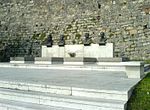Ivo Lola Ribar

Ivan Ribar (23 April 1916 – 27 November 1943), known as Ivo Lola or Ivo Lolo, was a Yugoslav communist politician and military leader of Croatian descent. In the 1930s, he became one of the closest associates of Josip Broz Tito, leader of the Yugoslav Communist Party. In 1936, Ribar became secretary of the Central Committee of SKOJ (Young Communist League of Yugoslavia). During World War II in Yugoslavia, Ribar was among the main leaders of the Yugoslav Partisans and was a member of the Partisan Supreme Headquarters. During the war, he founded and ran several leftist youth magazines. In 1942, Ribar was among the founders of the Unified League of Anti-Fascist Youth of Yugoslavia (USAOJ). He was killed by a German bomb in 1943 near Glamoč while boarding an airplane for Cairo, where he was to become the first representative of Communist Yugoslavia to the Middle East Command.In 1944, Ribar was awarded the title of People's Hero of Yugoslavia. Lola was the older of two sons of Ivan Ribar, the first President of Yugoslavia. His brother was another People's Hero, Jurica Ribar.
Excerpt from the Wikipedia article Ivo Lola Ribar (License: CC BY-SA 3.0, Authors, Images).Ivo Lola Ribar
Great Staircase, Belgrade Old Town (Stari Grad Urban Municipality)
Geographical coordinates (GPS) Address Nearby Places Show on map
Geographical coordinates (GPS)
| Latitude | Longitude |
|---|---|
| N 44.82194 ° | E 20.44891 ° |
Address
Гробница народних хероја
Great Staircase
11000 Belgrade, Old Town (Stari Grad Urban Municipality)
Central Serbia, Serbia
Open on Google Maps











